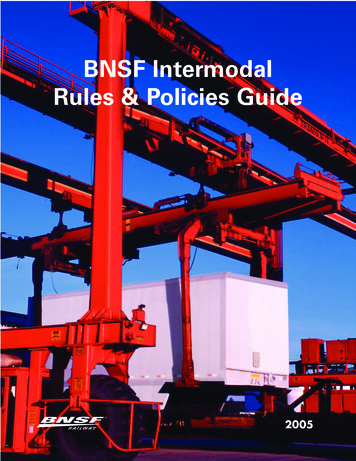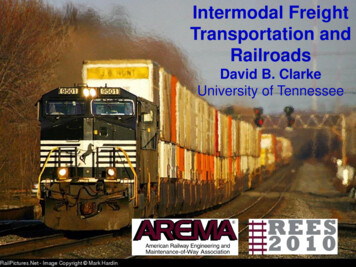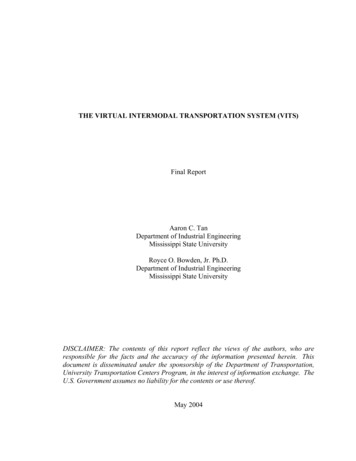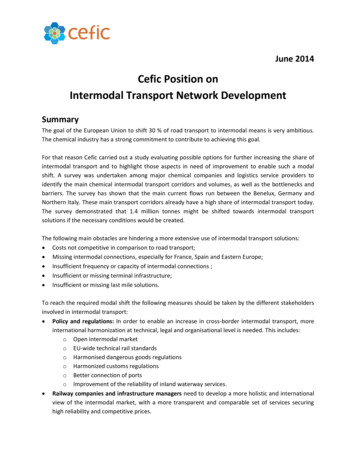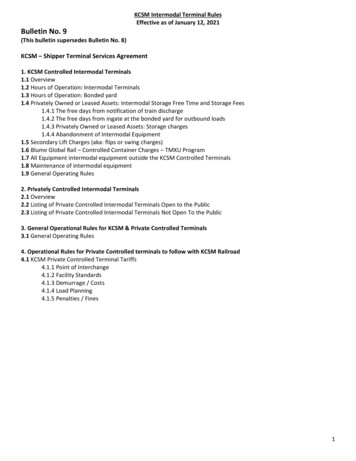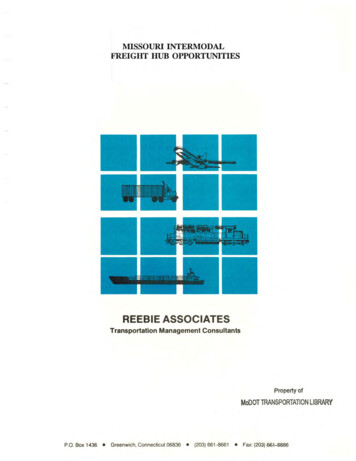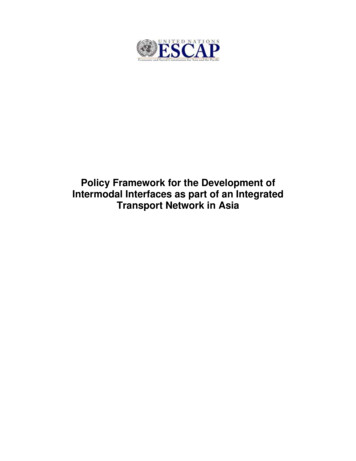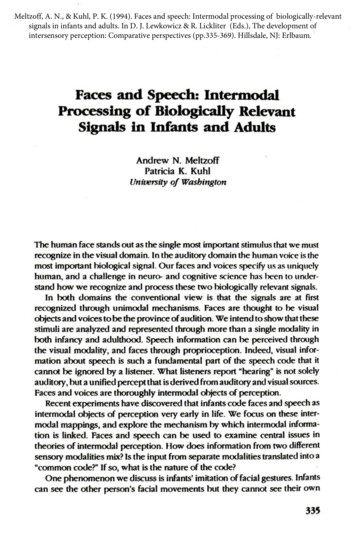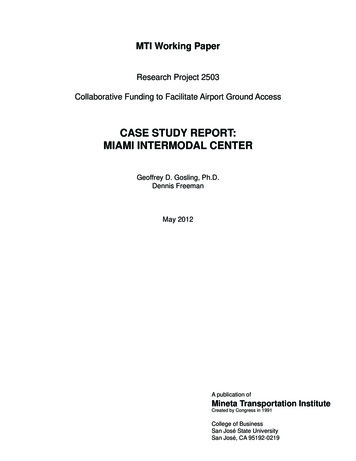
Transcription
MTI Working PaperResearch Project 2503Collaborative Funding to Facilitate Airport Ground AccessCASE STUDY REPORT:MIAMI INTERMODAL CENTERGeoffrey D. Gosling, Ph.D.Dennis FreemanMay 2012A publication ofMineta Transportation InstituteCreated by Congress in 1991College of BusinessSan José State UniversitySan José, CA 95192-0219
ii Mineta Tra n s p o rt a t io n I n s t it u t e
iiiCopyright 2012by Mineta Transportation InstituteAll rights reservedLibrary of Congress Catalog Card Number:2012938608To order this publication, please contact:Mineta Transportation InstituteCollege of BusinessSan José State UniversitySan José, CA 95192-0219Tel: (408) 924-7560Fax: (408) 924-7565Email: mineta-institute@sjsu.edutransweb.sjsu.eduMin e ta Tra n s p o rt a t io n I n s t it u t e
iv Mineta Tra n s p o rt a t io n I n s t it u t e
vACKNOWLEDGMENTSThe case study documented in this report has been prepared as part of the MinetaTransportation Institute Research Project Collaborative Funding to Facilitate Airport GroundAccess. The objectives of the research project include examining and documenting pastexperience with collaborative funding of airport ground access projects and the use ofdifferent funding sources to facilitate interconnectivity between transportation modes inorder to improve airport ground access.The authors would like to acknowledge and thank the sponsors of the research, the CaliforniaDepartment of Transportation, Division of Aeronautics and the Mineta TransportationInstitute (MTI).The authors also thank MTI staff, including deputy executive director and research directorKaren Philbrick, Ph.D.; director of communications and technology transfer Donna Maurillo;student research support assistant Joey Mercado; and webmaster Frances Cherman, whoalso provided editorial support.Helpful suggestions on the presentation of the material in this case study report werereceived from several anonymous reviewers as part of the peer review process for allresearch published by MTI.Min e ta Tra n s p o rt a t io n I n s t it u t e
viAcknowledgmentsMineta Tra n s p o rt a t io n I n s t it u t e
viiTABLE OF CONTENTSIntroduction 1Functional Components1History of the Project 5Project Costs 7Funding Sources 9Federal Funding11State and Local Funding12Rental Car Revenues13Summary and Conclusions 15Abbreviations and Acronyms 19Endnotes 21Peer Review 23Min e ta Tra n s p o rt a t io n I n s t it u t e
viiiTable of ContentsMineta Tra n s p o rt a t io n I n s t it u t e
ixLIST OF FIGURES1. Miami Intermodal Center 22. Rendering of Miami Central Station 33. MIA Mover Route 44. Potential Joint Development at Miami Central Station 55. AirportLink Metrorail Extension 66. Miami Intermodal Center Funding Min e ta Tra n s p o rt a t io n I n s t it u t e11
xList of FiguresMineta Tra n s p o rt a t io n I n s t it u t e
xiLIST OF TABLES1. Miami Intermodal Connector Estimated Project Costs 72. Miami Intermodal Connector Estimated Project Costs by Activity 93. Miami Intermodal Connector Funding Plan 10Min e ta Tra n s p o rt a t io n I n s t it u t e
xiiList of TablesMineta Tra n s p o rt a t io n I n s t it u t e
xiiiABSTRACTThis case study report documents the experience with collaborative funding of airportground access involved in the development of a major intermodal facility named the MiamiIntermodal Center (MIC), located adjacent to the Miami International Airport. The MICis being developed by the Florida Department of Transportation in cooperation with theMiami-Dade Aviation Department (MDAD), Miami-Dade Transit, and a number of otherstakeholders. The MIC project includes a Rental Car Center (RCC) that opened in July2010 and accommodates the operations of all on-airport rental car companies, as wellas serving as the pickup and drop-off location for all off-airport rental car companies, anautomated people-mover to transport passengers and their baggage between the MIC andthe airport terminals, that commenced operations in September 2011, and an intermodalfacility termed the Miami Central Station (MCS), that is projected to be completed in 2013.The MCS will provide a major regional intermodal hub for rail and bus services, includingthe regional Metrorail transit system, commuter trains operated by the South FloridaRegional Transportation Authority, and Amtrak.The MIC and associated infrastructure, including roadway and highway improvementsand an extension of the Metrorail system to the MIC, is projected to cost over 2 billionwhen completed. Funding for the project includes federal, state and local grants, mostlyprogrammed through the regional Transportation Improvement Plan and Long RangeTransportation Plan process, and federal and state loans through the federal TransportationInfrastructure Finance and Innovation Act (TIFIA) program, the Florida State TransportationTrust Fund, and the Florida State Infrastructure Bank. The extension of the Metrorailsystem from the existing Earlington Heights station to the MIC is being primarily fundedwith revenues from a half-percent local sales tax approved by Miami-Dade County votersunder a measure termed the People’s Transportation Plan. Revenue to cover the interestand pay off the principal on the 270 million TIFIA loan, as well as cover some of the landacquisition and construction costs for the RCC, the operating and maintenance expensesfor the RCC, and contribute toward the operating and maintenance costs of the automatedpeople-mover, is being provided from a Customer Facility Charge that is levied on all rentalcar transactions by the rental car companies operating in the RCC.The MIC is not only a major transportation project in its own right, but represents whatis easily the most ambitious attempt to date to create a major regional intermodal hubadjacent to a large U.S. airport. Not surprisingly for a project of this scale and scope, bythe time development of the MIC and associated infrastructure is completed, constructionwill have been underway for at least twelve years. As might be expected, the details ofthe project have also evolved over time and the funding plans have also had to evolve toaccommodate changes both in the cost and scope of the project, as well as take advantageof new funding opportunities that have emerged over the course of the project. Fundamentalto the successful completion of the project has been the unwavering commitment andfinancial support of the Florida Department of Transportation, as well as consistent supportfrom the Miami-Dade Board of County Commissioners and other regional stakeholders.Min e ta Tra n s p o rt a t io n I n s t it u t e
xivAbstractMineta Tra n s p o rt a t io n I n s t it u t e
1MIAMI INTERMODAL CENTERINTRODUCTIONThe Miami Intermodal Center (MIC) is a major intermodal facility located next to the MiamiInternational Airport (MIA) and connected to it by an automated people mover, as shownin Figure 1. The airport is located about five miles northwest of downtown Miami and is thelargest airport in Florida and a major international gateway for flights between the U.S. andthe Caribbean and Central and South America. In 2010, the airport handled 35.7 millionpassengers.Developed by the Florida Department of Transportation (FDOT) in partnership with theU.S. Department of Transportation, Miami-Dade County, the Miami-Dade ExpresswayAuthority, and the South Florida Regional Transportation Authority (SFRTA), the MiamiIntermodal Center provides a transportation hub that will improve access to and from MIAfor travelers with trip origins and destinations in Miami-Dade County and the larger SouthFlorida region, including Palm Beaches, Fort Lauderdale, and the Florida Keys. Whencompleted, the MIC will be served by several regional rail systems and long-distancebuses, as well as provide rental car and parking facilities to expand landside capacity atMIA.1 In addition, the MIC project includes access roads and a number of major highwayimprovements that will provide access to the MIC and improve access to MIA.2In addition to serving the transportation needs of the airport, an important component ofthe MIC program is a Joint Development strategy that has been established to stimulateeconomic development potential of the area and generate revenues that can be used topartially offset the capital costs of developing the MIC and support the long-term operatingcosts of the facility. This strategy includes public and private ground lease opportunitiesfor up to 1.4 million square feet of mixed use development that may be built in conjunctionwith the rail station being constructed as part of the MIC. Potential uses include offices,hotel and meeting space, additional parking, ancillary retail and restaurants.3As of the most recent program cost estimate available at the time of preparing this casestudy, the total MIC program was expected to cost a little over 2 billion. Funding for theproject is coming from a broad mix of federal, state, local and private sources, including anumber of federal and state loans.Functional ComponentsThe MIC project involves four major elements: a Rental Car Center (RCC), the Miami CentralStation (MCS), an automated people-mover between the MIC and Miami InternationalAirport, termed the MIA Mover, and major roadway and highway improvements.4Min e ta Tra n s p o rt a t io n I n s t it u t e
2Miami Intermodal CenterFigure 1. Miami Intermodal CenterSource: FDOT, Miami Intermodal Center – Project Overview, April 2011.The Rental Car Center provides a consolidated facility to serve all the rental car companiesformerly operating inside MIA and many of those located near the airport, and is intendedto significantly reduce congestion at the airport curbside and on terminal roadways. Itprovides 3.4 million square feet of vehicle parking and support facilities on four levels, eachcovering 20 acres, with space to accommodate up to 16 rental car companies. It includescustomer service facilities for rental car transactions, 6,500 vehicle parking spaces forfleet storage and staging, a ready/return car area, and a quick turnaround area (QTA) forwashing and refueling cars, with 120 vehicle fueling positions and 42 wash bays. Vehiclestorage and maintenance operations are located on the first three levels of the RCC whilethe fourth level includes a spacious customer service lobby and the ready/return area. TheRCC opened on July 13, 2010. Until the MIA Mover was completed in September 2011,Mineta Tra n s p o rt a t io n I n s t it u t e
Miami Intermodal Center3customers were transported between the MIA terminals and the RCC by a consolidatedshuttle bus system.5The Miami Central Station is designed to provide the primary intermodal groundtransportation hub for Miami-Dade County and the wider South Florida region, bringingtogether long-distance, commuter, and urban transit rail services, as well as intercity andurban bus services and ground access services for MIA.6 The MCS will include tracksserving Amtrak, SFRTA (formerly Tri-Rail) commuter trains, and Metrorail upon completionof the MIC-Earlington Heights Metrorail extension, renamed AirportLink in June 2010.7Provision has also been made for future high-speed rail trains, if such a system is eventuallydeveloped to serve the Miami region.East of the tracks will be a public esplanade, around which will be located private vehicleparking and bus depots for Greyhound, Miami-Dade Metrobus, intercity buses, courtesybuses and shuttles currently serving MIA, and taxis. The MCS will also include provisionsfor bicycles. The public esplanade will be linked with the MCS station of the MIA Moverby an elevated pedestrian walkway above the rail tracks, as shown in Figure 2. The MCSis envisaged as a major transfer point for users of rail and bus services in Miami-DadeCounty and the wider South Florida region that will improve connectivity not only for trips toand from Miami International Airport but for travel by public transportation throughout theregion. As of December 2011, it was envisaged that the MCS would be opened in 2013.Figure 2. Rendering of Miami Central StationSource: FDOT, “Miami Intermodal Center – Miami Central Station,”www.micdot.com/miami central station.html (accessed 5/27/11).The third major component of the MIC project is the MIA Mover automated people-moverlink between the airport and the MIC, as shown in Figure 3. The link has two stations, onein the airport and one in the MIC, and a dual-track guideway 1.25 miles long.8 The airportMin e ta Tra n s p o rt a t io n I n s t it u t e
Miami Intermodal Center4station is located on the third level of the airport terminal complex between the Flamingoand Dolphin Parking Garages and connects with the airport’s third-level moving walkways.The MIC station is located on the fourth level of the RCC between the RCC CustomerService Lobby and the MCS. Construction and operation of the MIA Mover is primarily theresponsibility of the Miami-Dade Aviation Department (MDAD) and forms the contributionof Miami-Dade County to the MIC project. FDOT contributed 100 million toward the costof the link, including construction of the guideway foundations and the MIA Mover stationwithin the MIC, for which it had responsibility. Construction of the MIC station began inFebruary 2008, with construction of the MIA station starting in March 2009.Figure 3. MIA Mover RouteSource: FDOT, Miami Intermodal Center – MIA Mover Fact Sheet, September 2011.Construction of the guideway foundations commenced in June 2009 and was completedat the end of December 2009. The MIC station was completed in January 2011 and theMIA Mover became operational on September 9, 2011 with the completion of the MIAstation. The MIA Mover is capable of transporting over 3,000 passengers per hour alongwith their luggage. Passengers ride the system free of charge.The MIC project also includes improvements to roads and highways serving the MIC,MIA, and the area surrounding the airport. Roads and highways that will experienceless traffic congestion include Le Jeune Road, State Road 112, and State Road 836.9During construction of the MIC and roadway improvements the traveling public in the areasurrounding MIA, including the Cities of Miami, Miami Springs, Hialeah, and Coral Gableswas expected to experience some adverse traffic impacts. The MIC Program establisheda Comprehensive Community Awareness Program and One-Stop Shop traffic informationservice to keep elected officials, community leaders and the public informed of the progressbeing made on the project and provide up-to-date information on lane closures, detours,and the status of construction projects in the airport area.10Mineta Tra n s p o rt a t io n I n s t it u t e
Miami Intermodal Center5A key element of the MIC Program is a joint development strategy that would capturesome of the economic development potential stimulated by the project through public andprivate ground lease development opportunities.11 It is envisaged that up to 1.4 millionsquare feet of mixed-use development could be built in conjunction with the MCS, with anadditional 4.5 million square feet of mixed-use development on privately owned land to theeast of the MCS, as shown conceptually in Figure 4. Possible uses could include hotels,offices, retail and entertainment. When built out, it is anticipated that this development willhelp offset the capital and long-term operating costs of the MIC.Figure 4. Potential Joint Development at Miami Central StationSource: FDOT, Miami Intermodal Center – Project Overview, April 2011.Although initially not part of the MIC Program, the 2.4-mile AirportLink Metrorail extensionfrom the existing Metrorail Earlington Heights Station to the MIC shown in Figure 5 formsa key element of the overall project. This extension will terminate at the MCS, from wherepassengers can access the airport via the MIA Mover. Miami-Dade County broke groundon the extension in May 2009 and as of December 2011 the extension was scheduled toopen in the spring of 2012,12 although the MCS is currently not expected to be completeduntil sometime in 2013. By June 2012, the planned opening of the extension had slipped tolater in the summer. The majority of the funding for the 506 million project will come froma half-percent sales tax under the People’s Transportation Plan, discussed further below,with FDOT contributing 101.3 million.HISTORY OF THE PROJECTThe purpose of developing the Intermodal Center was mainly to connect surroundingregions near the airport and to decongest local and regional roads. Planning for theIntermodal Center started in the early 1980’s, although development was postponeddue to environmental reasons. In 1989, after the passage of the Intermodal SurfaceTransportation Efficiency Act (ISTEA), local planners decided to continue to pursue theMin e ta Tra n s p o rt a t io n I n s t it u t e
6Miami Intermodal Centeridea of an intermodal center for the airport. The main thought at the time was to link twomajor rail systems, Tri-Rail and Metrorail, with the airport.13Figure 5. AirportLink Metrorail ExtensionSource: Miami-Dade Transit, “AirportLink Metrorail Extension Project,”www.miamidade.gov/transit/improve airport.asp (accessed 12/10/11).In 1993, the local agencies planning the intermodal center joined with FDOT, six federalagencies, and the U.S. Department of Transportation (USDOT) to undertake the planningand design of the facility. In 1995, the Federal Highway Administration (FHWA) approvedFDOT’s Major Investment Study/Draft Environmental Impact Statement. In May 1998,FDOT granted Kaiser Engineers a contract to serve as consultant program manager for theMIC Program. The following month the U.S. Congress passed the Transportation EquityAct for the 21st Century (TEA-21). Along with the passage of TEA-21, the TransportationInfrastructure Finance and Innovation Act of 1998 (TIFIA) was created to provide a federalcredit program to invest in national and regional transportation programs. FDOT applied fora TIFIA loan for the MIC Program and was awarded 439 million in two separate installments.Since 2000, FDOT has been working with the Miami-Dade Board of County Commissionersand the rental car companies to pursue development of the MIC. Recognizing the need forbroader inter-agency cooperation and coordination, in 2000 FDOT entered into strategicpartnerships with Tri-Rail (now the SFRTA), Miami-Dade County, and the Miami-DadeExpressway Authority, and in 2001 formed a MIC Steering Committee with representativesof twelve participating stakeholders and associated agencies, including the Miami-DadeCounty Metropolitan Planning Organization, the greater Miami Chamber of Commerce,and the Greater Miami Convention and Visitor Bureau.14In 2005, the latest revision to Federal surface transportation funding legislation, the Safe,Accountable, Flexible, Efficient Transportation Equity Act: A Legacy for Users (SAFETEALU), was passed and included the MIC within its funding plans. In addition, Florida SenatorMel Martinez and Congressman Mario Diaz-Balart inserted a provision in SAFETEA-LUMineta Tra n s p o rt a t io n I n s t it u t e
Miami Intermodal Center7that allowed FDOT to count its 100 million contribution to the MIC-Earlington HeightsMetrorail extension, which did not have a Federal funding component, as matching fundsfor other Miami-Dade transit corridors.15Construction of the MIC began in 2001 with initial work by FDOT on the MIC roadwayimprovements, with utility and foundation work for the RCC commencing in June 2003following award of a Construction Manager at Risk (CM@Risk) contract to TunerConstruction Company. The improvements to Le Jeune Road and the MIC-MIA interchangewere completed in May 2008, marking the first component of the project to be completed.The RCC was completed in July 2010, with the MIA Mover becoming operational inSeptember 2011, as noted above. As of the date of this case study, work is continuing onthe MCS with a planned opening in 2013.PROJECT COSTSDetailed information on the evolution of project costs for the various elements of the MICdevelopment program is available from the Annual Financial Plan Updates prepared byFDOT. As of the date of this case study, the most recent Annual Financial Plan Update wasdated May 31, 2011 and included cost estimates (actual costs in the case of completedelements) as of the April 2011 work program.16 The estimated project costs for the variouselements of the overall program are shown in Table 1 as of the April 2011 work program,together with changes from the April 2010 work program and an earlier cost estimateprepared in July 1999 in support of an application for a federal loan under the TransportationInfrastructure Finance and Innovation Act.Table 1.Miami Intermodal Connector Estimated Project CostsAmount (000)July 1999 TIFIALoan ApplicationApril 2010 WorkProgramApril 2011 14Road improvements143,424187,834186,950MIC/MIA connector (people-mover)399,680270,116270,071Rental car 72,043,216Right-of-way acquisition and environmentalremediationInitial MIC Core (Miami Central Station)Capitalized interestRental car facility reserves and costsSource: FDOT, MIC 2011 Annual Financial Plan Update, May 2011.Overall the estimated project costs increased by a little over 54% from 1999 to 2010. Thelargest contribution to this increase was the Miami Central Station, the estimated cost forwhich increased to more than nine times the original estimate, followed by the rental carMin e ta Tra n s p o rt a t io n I n s t it u t e
8Miami Intermodal Centerfacility, the estimated cost for which increased by about 145%. However, the apparentincrease in cost for the Miami Central Station is misleading because the 2010 and 2011estimates include the AirportLink extension of the Miami-Dade County Metrorail system,which was considered a separate project in 1999 and not included in the 1999 MIC costestimate. The current estimated cost for the AirportLink extension is 540.2 million, withthe other components of the MCS projected to cost 199.0 million, an increase of 147%over the July 1999 estimate. This increase reflects a significant change in the design of theMIC since the July 1999 estimates were prepared. At that time it was envisaged that thearea to the east of the RCC on the current site of the MCS would be used for a landsideterminal for MIA, with rail connections to the MIC located at a “Rail Node” north of NW 25thStreet that would provide a station for Tri-Rail (now SFRTA) services. Subsequently MDADdecided to forego a landside terminal and the Miami-Dade Board of County Commissionersdecided to develop the MCS on the site to improve the intermodal connections betweenthe MIC and Metrolink and Amtrak as well as Tri-Rail (and any other future rail services).17The total estimated project cost reduced slightly from 2010 to 2011, due primarily toreductions in the estimated costs to complete the MCS ( 21 million), estimated capitalizedinterest ( 20 million), and estimates of other costs including the cost of roadwayimprovements ( 7 million), partly offset by an increase of 8 million in the cost of the RCC.The project costs shown in Table 1 include separate program elements for right-of-wayacquisition and environmental remediation, and capitalized interest. While these areshown as separate elements, these costs result from the various physical elements of theMIC project. The breakdown of the total cost shown in Table 1 into the different types ofactivity is shown in Table 2.As could be expected, the largest component of the estimated costs was for construction,which by April 2011 accounted for about 70% of total project costs. The second largestcomponent was right-of-way acquisition, which accounted for about 15% of total projectcosts. Design activities accounted for less than 5% of total project costs, while projectengineering, feasibility studies, preparation of National Environmental Protection Act(NEPA) documentation, project administration, and construction engineering and inspectionaccounted for somewhat over 6% of total project costs. Environmental remediation costsaccounted for less than 2% of total project costs. By April 2011, program contingency costshad decreased to only 0.4% of total project costs since these estimated costs decrease asconstruction of different elements of the project are completed.Estimated financing costs accounted for only 1.6% of total project costs, the largest partof which was the estimated capitalized interest on a TIFIA loan for the rental car facility.By April 2010 the estimated capitalized interest on the original TIFIA loan for the projectwas significantly reduced from the initial estimate in 1999 due to the refinancing measuresdiscussed further below in the section on Federal Funding, although the estimatedcapitalized interest on a second TIFIA loan for the RCC had increased due to an increasein the amount of the loan, also discussed below. This increase was largely eliminated byApril 2011 by refinancing the TIFIA loan with a loan from the Florida State InfrastructureBank (SIB) at a more favorable interest rate.Mineta Tra n s p o rt a t io n I n s t it u t e
Miami Intermodal CenterTable 2.9Miami Intermodal Connector Estimated Project Costs by ActivityAmount (000)July 1999 TIFIALoan ApplicationApril 2010 WorkProgramApril 2011 73,03732,34532,345123,42691,67194,605Project administration33,15247,99848,820Construction engineering and IA capitalized interest - FDOT32,3272,1072,107TIFIA capitalized interest - RCC29,06351,85728,352Program ActivityProject engineering, feasibility studies, and NEPAdocumentationRight-of-way acquisitionEnvironmental remediationDesignConstructionProgram contingencySubtotal before financingFinancingSIB capitalized interest2,558Rental car facility reserves and 342,083,3372,043,216Source: FDOT, MIC 2011 Annual Financial Plan Update, May 2011.FUNDING SOURCESIn addition to details on project costs, the Annual Financial Plan Updates also providedetails on funding sources. The MIC Financial Plan draws on a range of federal, stateand local funding sources, as well as private-sector contributions.18 By April 2010, themajority of the funding comprised a combination of federal, state, and local fundingprogrammed through the Miami-Dade County Transportation Improvement Program (TIP)and Long Range Transportation Program (LRTP). In addition, the financing plan includeslocal funding contributions from the MIA Airport Capital Improvement Plan, Miami-DadeExpressway Authority toll revenue and revenues from the rental car companies using theRCC. Initially it was anticipated that the Miami-Dade Transit Agency (MDTA), as it wasthen called, would provide some funds from its local revenues, although this was laterdropped from the financing plan.In addition to grants and other direct revenues, the financing plan for the project relies ona number of major loans. As a project designated by the federal government as a Projectof National Significance, and subsequently designated a Major Project, the MIC Programwas eligible to apply for a federal TIFIA loan. FDOT applied for and received two TIFIAloans for the project, as discussed in more detail below in the section on Federal Funding.Additional loans have been made or committed by the Florida State Transportation TrustFund and the Florida State Infrastructure Bank.Min e ta Tra n s p o rt a t io n I n s t it u t e
Miami Intermodal Center10As can be expected in a complex project of this scale and duration, the financing plan hasevolved over time, in part to reflect changing estimates of the total cost to complete theproject and in part due to changes in the sources of funds planned to finance the project.The planned amounts and sources of funding as of the April 2010 and April 2011 workprograms and the initial funding plan in the July 1999 TIFIA loan application are shown inTable 3.Table 3.Miami Intermodal Connector Funding PlanAmount (000)July 1999 TIFIALoan ApplicationApril 2010 WorkProgram106,71823,0586,353TIP/LRTP and prior plus other state157,0331,072,0431,047,548Airport Capital Improvement Plan399,680159,343155,196Dedicated revenues from RCC25,000110,697113,496Miami-Dade Expressway tolls86,56886,16986,157MDTA non-federal contributions15,000Ancillary Source of FundsApril 2011 WorkProgramFederal contributionsTIP/LRTP and priorState and local contributionsSubtotalFinancingTIFIA loans plus capitalized interestState Transportation Trust Fund loanSIB loan plus capitalized interestSubtotalTotalSource: FDOT, MIC 2011 Annual Financial Plan Update, May 2011.As shown in Table 3, by April 2011, state and local funds were planned to account forabout 69% of total project funding, of which by far the largest share (75% of state and localfunds) consists of state and local funds programmed through the TIP/LRTP and other statefunds. The share of project funding planned to be contributed from the MIA Airport CapitalImprovement Program dropped significantly over the course of the project, until by April2011 it accounted for less than 8% of total funding (11% of state and local funds). TIFIAand state loans, which of course have eventually to be repaid, accounted for about 31% ofthe planned project funding.In addition to a wide range of federal, state and local government funding sources,somewhat less than 6% of the total project funds are projected to be provided from feerevenues from the rental car co
Intermodal Center (MIC), located adjacent to the Miami International Airport. The MIC is being developed by the Florida Department of Transportation in cooperation with the Miami-Dade Aviation Department (MDAD), Miami-Dade Transit, and a number of other stakeholders. The MIC project includes a Rental Car Center (RCC) that opened in July

